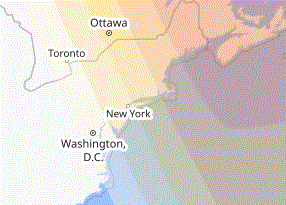TGT #25E - A Partially Shy Sun - Venus in the Evening AND Morning - A Constellation in Georgia - No Rings, Many Moons
TGT 3/16/25: SPC--Evening Sky Loses 3 Planets, But Venus is in the Evening AND Morning; A Partial Solar Eclipse; Astronomy in Everyday Life--Georgia on my...Universe?; TJI-Saturn, + Moons, - Rings.
Cover Photo - What a Difference Two Weeks Makes

In This Issue:
Cover Photo — What a Difference Two Weeks Makes
Welcome to Issue #25E!
Sky Planning Calendar —
* Moon-Gazing -
* Observing—Plan-et - Venus and Mercury, Planetary Space Rocks, Drop Like Rocks Out of the Evening Sky, Quickly Enter Dawn
Deeper Look: A Partially Shy Sun - March 29th Solar Eclipse
This Just In — A World Minus Rings But Plus Many Moons
Astronomy in Everyday Life —Georgia on my….Universe?
Welcome to The Galactic Times Newsletter-Inbox Magazine #25E!
Greetings, Galactic Timers!
This issue will be shorter than usual. As I have mentioned before, I also write books and I’m currently in THE heaviest travel part of a book tour revolving (there’s an astronomical play on words!) around the Bicentennial of the Marquis de Lafayette’s Grand Tour. Every 2-5 days I’m on the road to or from somewhere. So I’ve just got a few basics for you. Things get closer to normal in April/May. Thanks for your patience.
- - - - -
The Cover Photo shows what can happen in two weeks time. On the left the Moon is a pretty white crescent hanging over brilliant Venus in the West, in an evening twilight scene. Two weeks later, the Moon is in the East, middle of the night, looking like Mars next to the star Beta in the constellation of Virgo. The Moon is looking red and white due to being in Earth’s shadow, though clearly the shadow is not uniform in density—the “polar cap” is just the thinner outer part of the Earth’s shadow not fully blocking all colors in the sunlight. And Venus, if one had looked, is nowhere to be found in the sky, morning or evening.
- - - - -
As the Sky Planning Calendar shows, our evening sky full of five bright planets rapidly drops to two as three worlds drop like rocks from darkness to conjunctions to the Sun. But one has the rare chance to be seen in the evening AND morning twilights of the same day for several dates!
The Sun puts on shades; well, it tries to. Not very successfully. We have a partial solar eclipse on the 29th, for far northeastern US, eastern Canada, and most of Europe, and the arctic lands of Greenland and Iceland. Details in Deeper Looks.
As mentioned above, I have been traveling, and Georgia had a nice bunch of astronomical words in non-astronomical contexts. Read Astronomy in Everyday Life.
- - - -
Do you want to get these issues right away in your mail inbox? Then subscribe. We don’t put the latest issue up on the Substack webpage until a week later.
* Not a Subscriber? Want to read this off the Web? Please hit the link..right… below:
Enjoy!
Publisher — Dr. Larry Krumenaker Email: newsletter@thegalactictimes.com
Sky Planning Calendar
Moon-Gazing
Moon passages by a star, planet or deep sky object are a good way to find a planet or other object if you’ve never located it before.
March 17 The Moon is at its smallest diameter for the month, it is at Apogee, its farthest distance from us.
March 21 In the dawn and pre-dawn you’ll find the Moon to the lower right of Antares, the red heart of the Scorpion. Down-Under you’ll find the star, well, under the Moon, as in behind it.
March 22 Last Quarter Moon.
March 29 A week later it is New Moon, but this one is a little special. The Moon also crosses the Earth’s orbital plane, i.e. the Ecliptic, and causes a partial eclipse of the Sun. See below.
March 30 To add to it, the Moon at the time of the eclipse is just hours away from its Perigee, its closest time of the month to Earth, and thus at its largest apparent size….today.
Observing---Plan-et
==Planetary Rocks Mercury and Venus Drop Like Rocks Into the Solar Glare
and Back Out of It==
Mercury and Venus disappear together from the evening sky and reappear rapidly in the dawn. On the 18th and 19th—Venus first date and Mercury on the second one— the planets set 40 minutes after Sunset, the traditional last day to ‘easily’ find them in the twilight. Five days later, for each, [23rd and 24th] they pass ‘between’ us and the Sun. If it were EXACTLY between, we’d have little black dots crossing the solar disk in a space of a few hours; these are called transits. Venus’ is rather rare, Mercury not quite so rare but not common. Mercury’s next transit is in 2032, seven years from now roughly. Venus…..in another century almost exactly.
What’s neat is also their reappearance act in the dawn. In fact, if you have very clear horizons in between East and ENE, you can find Venus about 30 minutes before sunrise on the 23rd, the day of solar conjunction, a thin 1% crescent in binoculars on the horizon . Venus’ orbit is tilted enough to pass about 8-9 degrees above the Sun’s North Pole from our perspective. So with care you can spot Venus in the evening AND mornings of the same day for a few days around this date.
Oddly, Venus rises more than 40 minutes before the Sun starting the 22nd, and Mercury the same but lagging off to April 1st.
Earth and its Earthlings get equal days and nights on the 20th, the Vernal Equinox as named in the Northern Hemisphere at 4:01 AM CDT.
Mars and Jupiter are all that’s left in the evening sky. Mars, fading and shrinking telescopically, is due South at the end of evening twilight on the 18th, setting about an hour and a half before morning twilight begins. It can be found in a lopsided triangle with two bright-ish stars, Castor and Pollux, the Gemini twin stars. Jupiter, sets around 1 AM Daylight Saving Time, otherwise known as standard time midnight. Thus is about to leave the morning sky solely to Mars until the inner planets get further away from the Sun.
And what about Saturn? It had a conjunction with the Sun around the 12th. On the 23rd Earth passes through the Saturnian ring plane. If it wasn’t so close to the Sun you could see a ring-less gas giant, a smaller and paler (fewer bands in its atmosphere) and much yellower version of Jupiter. But it and the flip side of its rings won’t be easily visible until May and afterwards, in the dawn. For more on the ringless world, see below.
Deeper Look: The Partially Shy Sun
Do you still have your Solar Eclipse glasses from last year’s Total Eclipse across North America? Don’t put any fingerprints on them as you pull them out of some cubbyhole. We have a partial solar eclipse 15 days after the recent Total Lunar Eclipse, on March 29th.
Well, some of us have one.
This is just a partial, for everyone in the zone. No totality anywhere; the Moon just manages to cover some part of the Sun, the lunar shadow passing over in space above the Earth’s North Pole.
For North Americans you have to be north and east of Washington, DC (right now, a very good idea….). The further N and E you go the higher the percentage of the Sun’s disk that is covered by the Moon, around 60+ percent. But this all takes place at and just after Sunrise, ending within a few minutes of 6 AM Local Daylight Savings Time.
There’s a larger chance for TGT’s European viewers. The extreme Southeast edge of the viewing zone goes from roughly NW Africa across Italy, the Ukraine and Russia. The obscuration gets greater as you move to the North and West, towards the Baltics-Germany-Spain line. The United Kingdom, then Iceland and Greenland get the max view. Time for a North Atlantic trip?
This Just In
A World Minus Rings But Plus Many Moons
As we went to press, the New York Times had an early report of a research article on the discovery of over 100 new moons around Saturn, giving it not only more than any other world, including even bigger Jupiter, but also more than 200 of them. Most of them are tiny rocks at most a few miles across. These were discovered using space telescopes, but in other days new moons were discovered there during a special Saturnian time that occurs every roughly 15 years. This is when the ringed world appears…ringless.
Saturn’s rings would seem to have disappeared if one could view the world from Earth during the two weeks of this issue’s lifetime. Our Earth is appearing to cross the ring plane of Saturn and the incredible thinness of the rings, likely less than a mile, makes them disappear….and removes the glare of reflected sunlight from the rings such that moons orbiting in the ring plane that are small can briefly stand out.
In the photo above one can see only a hint of the rings, as a slightly darker line on the edge of a dark (relatively) band at the same height above the photo’s bottom edge as the moon on the left. This shows you why these few days of no-ring reflected light reveals usually hidden moons.
But this brings up a question. The rings are not a solid plane of material but millions of tiny, well, moons. But these are never actually labeled as moons. Moonlets best describes them. Why are the newly discovered moons, small as they are even if not as small as the ring’s moonlets, NOT called moonlets?? Shouldn’t the IAU contemplate making a distinction about objects orbiting a planet into two or three kinds, the way we now distinguish between planets and dwarf planets and minor planets? Shouldn’t we have moons and, say, minor moons and moonlets?
Astronomy in Everyday Life
Georgia on my….Universe?
As mentioned above I have been traveling heavily in the US Southeast states. To my surprise, I saw a LOT of astronomical terms used in non-astronomical contexts in the state of Georgia!
One evening I ate dinner at an Applebee’s restaurant, a general American food fare chain. Apparently someone in the marketing department has a real interest in astronomy, especially in servings from the bar:
For those not night owls….
Now to get to an Applebee’s, you don’t have to go to the ends of the Earth….or maybe you do….if the end is the Omega to your starting point Alpha…..
Heck, let’s leave this planet and head to the stars…..I passed this town on the way to my destination. I wonder if they know there is a constellation by its town name?
A Patreon account has been set up for The Galactic Times. Right now, the one tier is simply a $2.50 monthly support for your kindness, since The Galactic Times is an otherwise free newsletter now. But we can use the help.
To support TGT, please head over to our Patreon for The Galactic Times site.‘










